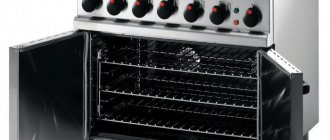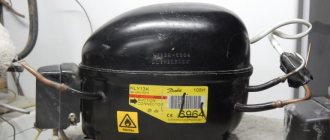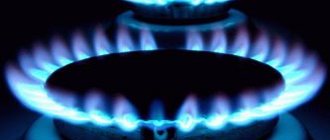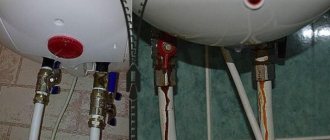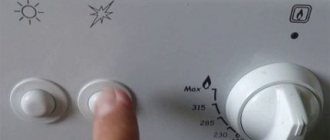Gas heating water heaters are devices with sufficient reliability and, if used carefully in accordance with the instructions and with proper care, can last for quite a long time. However, all devices can sooner or later break down, fail and require repair. Experts advise trusting the repair of geysers to professionals in this matter.
Geysers are heating devices with sufficient reliability and, with proper and proper care, can last for quite a long time.
However, you can learn to identify and eliminate some breakdowns yourself before the arrival of specialists.
What kind of breakdowns can occur, what a wick, thermocouple, igniter is and what to do if the gas water heater goes out will be discussed below.
What to do if the gas water heater goes out
The main reason for the fire going out in the column during ignition may be low draft or its complete absence in the ventilation duct. One of the most common reasons is a tightly closed plastic window. There is no air flow, and therefore the column overheats and the thermal protection relay for the gas column against overheating is triggered. If, when you open a window or door, after 10-15 minutes the column lights up and does not go out, then the reason for the extinguishing lies precisely in the overheating of the column.
The most common reason for the lack of draft in a gas water heater is a tightly closed window.
Provided that the chimney may be clogged with products resulting from combustion or if a foreign object has entered it, the protection system in the water heater begins to operate and the gas is shut off automatically. How to check the presence or absence of draft in the chimney? It is enough to open the window and place a lit match or palm on the chimney opening. When draft is present, the flame will be deflected and you will feel a breath of air in your palm.
How to fix the problem? The answer is simple: clean the chimney and ventilation duct. Companies can help you with this; upon request, their specialists will come to you and clean your chimney.
Another reason for the gas burner flame going out may be the process of discharging the power elements. If your column has automatic ignition from generators or batteries, then you will have to replace them with new ones, having first checked the “On/Off” key.
The lack of cold water or its weak pressure is another reason why the gas water heater turns off.
Why does the column light up and go out?
If the gas flow heater turns off after ignition, you need to ensure:
- How the pilot light goes out (extraneous sounds may be heard).
- How long after ignition does the burner go out?
The reasons are similar for almost all Beretta, Junkers, Oasis, and Bosch models. Additionally, read the article “Column Vector does not light up and other malfunctions.”
Lack of draft in the hood
As a rule, this is caused by a dirty chimney. During operation, combustion products enter it and settle in the form of soot on the walls. Therefore, the ventilation duct requires systematic (once a year) maintenance.
Checking the presence of draft is simple: you need to bring a lit match to the hood. If it functions adequately, the flame should move towards the exhaust path.
Often, a lack of normal draft occurs when plastic windows into a room are tightly closed - they impede the flow of air. During operation, the protective relay overheats, the security system is activated and the device turns off.
Flame ionization sensor malfunction
The fact that the problem is related to the ionization sensor can be understood by the fact that the column goes out almost immediately. The fact is that it is in constant contact with fire, during which ions are produced. They, in turn, are responsible for generating current. And if there are few ions, then the equipment will not turn on normally.
The main signs of a faulty sensor are as follows:
- the burner lights up, but goes out after a couple of seconds;
- If you turn on the column again after this, it will work a little longer;
- the column will light up normally after several consecutive turns on;
- This defect appears when the device is rarely used.
You can try to solve the problem yourself first. To do this, you need to check all the wiring connecting the sensor and the control board. It is important to make sure that all contacts are working properly. After this, unscrew the screws, remove the cover and move the heating electrode closer to the center of the flame. This will extend the life of the part. If these manipulations do not help, then it is better to turn to professionals.
The problem is in the membrane of the water unit
The membrane must be made of elastic material. During operation, its properties are lost, it becomes hard, cracks and scale appear on the surface. As a result, the part may deteriorate so much that the column will go out.
To eliminate this malfunction, you should inspect the membrane and, if it is damaged, replace it.
Advice! In this case, it is better to purchase a part made of silicone - it will last much longer.
The wick is clogged with dust
In models with an igniter, this part often becomes clogged. The flame becomes weak and a yellow tint appears. But a change in the color of the flame may also indicate a lack of air in the gas-air mixture.
The result is that the device is either completely unable to ignite the burner, or performs its function after a large volume of fuel has been supplied. In the latter case, a characteristic bang is heard.
To clean the element you will need two screwdrivers (Phillips, slotted) and an adjustable wrench.
Repair of a gas water heater
The next reason why your geyser turns off is the lack of water or its low pressure. If you open a cold water tap and see insufficient pressure, as in a hot water tap, then the reason is in the entire plumbing system.
Provided that the pressure of cold water is stronger than hot water, this means that the reason lies in the water unit of your unit. The cause of the problem may be clogging of the filters at the inlet of the unit or deformation of the membrane. The reason may also lie in clogged hot water pipes themselves. If you have additional deep water filters installed, then if they become clogged, the water pressure may decrease similarly.
How to troubleshoot when the gas heater goes out?
The first thing you can do is wash the filters yourself or replace them with new ones. The second is to call a utility company to determine the lack of water pressure in your system. Specialists will help you either flush the pipes or clean the column from combustion products and soot. The membrane on the water unit may also need to be replaced.
How to troubleshoot when the gas heater goes out?
The first thing you can do is wash the filters yourself or replace them with new ones. The second is to call a utility company to determine the lack of water pressure in your system. Specialists will help you either flush the pipes or clean the column from combustion products and soot. The membrane on the water unit may also need to be replaced.
Depleted ignition batteries may also be the reason why the gas water heater does not light up.
There are often cases when a gas water heater lights up and immediately goes out. The solution to this problem is to regulate the supply of hot and cold water. There is no need to dilute hot water with cold water, as this leads not only to the extinguishing of the flame, but also to improper operation of the gas water heater. To regulate the supply of cold water, you need to reduce its supply in the tap by turning the valve.
The problem when the gas water heater turns on with pops and goes out can be caused by a lack of draft, clogging of the nozzle and other parts of the water heater, due to a strong influx of gas, as well as due to the discharge of the ignition batteries. It’s not hard to guess how to fix the above problems: replace the batteries, clean the chimney, call specialists to fix the breakdowns.
The geyser goes out: Reasons
There may be several reasons why a geyser goes out. Repairing such a water heating system requires the involvement of qualified specialists. However, there are a number of simple reasons why the water heater may also turn off. The user can install and fix them independently.
If the gas flow heater turns off after ignition, you need to ensure:
- How the pilot light goes out (extraneous sounds may be heard).
- How long after ignition does the burner go out?
The geyser goes out immediately after being turned on
If the water heater turns off immediately after starting, most likely the ionization sensor has failed. It is responsible for the presence of a flame in the burner.
How to understand what the problem is:
- The burner goes out 3-5 seconds after ignition.
- Restarting is accompanied by longer work.
- After a few starts, the equipment begins to function normally.
- After a “rest” the problems recur.
Solution: Inspect the wiring that leads from the sensor to the control board. If everything is in order, the part will need to be replaced.
Ignition and instantaneous extinguishing of the gas water heater
This situation most often occurs due to improper operation of the device by users. When such a water heater is in working condition, it is strictly forbidden to open cold water to dilute hot water. This action is a most dangerous violation of the rules of its use. It can cause serious damage to the device. The temperature of the liquid is regulated solely by supplying gas.
Faulty ignition system
Depending on the models, there are three types of ignition: electric ignition (in modern versions), an igniter, which has a small constant flame, and a hydraulic turbine - from pressure.
The electric ignition runs on built-in batteries. According to manufacturers, they last for about a year. But as practice shows, the service life of such batteries is shorter. For example, in the Bosch gas water heater models W 10 KB or WR 10-2 B, there is an LED on the front panel that indicates the status of the batteries. The Neva Lux range of gas water heaters is also equipped with this type of ignition. If necessary, old batteries are replaced with new ones.
If the cause of the problem is the wick, then it is best to seek help from qualified specialists. They will check the functions of the thermocouple and gas control system, clean and adjust the igniter. Often, the problem when the pilot light of a gas water heater goes out is solved by completely cleaning the water heater.
In the case of a hydroturbine type of ignition, for example, as in the Bosch WRD 13-2 G or WRD 10-2 G, a malfunction may occur due to the lack of water pressure on which it is based.
Microexplosions during ignition
These unpleasant processes are only a consequence of low thrust, unsuitable batteries, contamination of the device itself, or a very large volume of gas supplied to the column. To troubleshoot the problem yourself, the owner can only clean the exhaust duct or replace the batteries. If the problem is not solved, then only gas service employees can understand why the dispenser goes out.
The column lights up normally, but after a few minutes of operation it goes out.
A sensor that reacts to combustion products has triggered. Probably, too many of them have accumulated and they are not displayed. Possible reasons:
The chimney is clogged with soot, soot, and debris.
Reasons: there is no normal traction, the work is not carried out.
Solution: you need to clean the chimney opening on your side. If this does not help, contact the management company.
There is powerful ventilation nearby
Reasons: waste is drawn into the ventilation hole.
Solution: while the column is operating, turn off the ventilation or set the ventilation to minimum power.
Repair of a gas burner with automatic protection system
More complex reasons for the extinguishing of a geyser with an automatic protection system will be described below.
To repair a gas water heater, you must have a clear understanding of how the components of the protection system work.
In geysers with an automatic protection system, the gas in the igniter must burn continuously, even regardless of the position of the handle, tap valves and mixers for water supply. The simplest automatic protection system for geysers consists of three elements: a thermocouple, a thermal fuse, and a solenoid valve. The wick of the geyser goes out when the protection elements are triggered or when the thermocouple malfunctions or the igniter is clogged.
If the automation elements fail, evidence of their inoperability is the process when the igniter of the gas water heater goes out after the gas control knob has stopped being held. To carry out repair work, it is necessary to clearly understand how the components of the protection system work.
Causes of malfunction of a gas-powered water heater
There are many reasons why certain complaints about speakers arise.
In a situation where
the gas water heater smokes, goes out or does not light up you can try to fix the problem on your own, but the best outcome would be to call a technician.
Let's take a closer look at the possible causes of geyser malfunctions.
Impossibility of igniting the igniter (wick)
Most often, this phenomenon occurs in gas water heaters. There are two reasons why the igniter does not fire:
- If there is no draft in the chimney, the electronic control system shuts off the gas supply.
A lack of draft indicates the need to clean the chimney, which can be clogged with soot and dust, or various debris, including construction debris. It is also necessary to make sure that craftsmen have not installed television antennas or other structures above the chimney on the roof, which in itself is a violation of safety regulations.
- Damage to the piezoelectric element is characterized by the absence of an ignition spark. Quite often there are models of geysers whose ignition systems are powered by simple batteries. In this case, to eliminate the problem, you should try replacing the batteries.
Many owners of gas water heaters (Junkers) equipped with piezo ignition often encounter the problem of igniting the igniter.
Short-term burning of a lit igniter followed by its extinction
The situation when the wick burns, but soon goes out, arises due to the fact that:
- The gas regulator is not held down long enough. The minimum pressing time is 10 seconds. During this time, gas is forced into the system, and the wick begins to warm up. An automatic control system monitors the temperature at the igniter - when it cools down, the gas supply is cut off.
- For normal functioning of the igniter, a certain draft is required. A clogged chimney and a littered ventilation system interfere with air flow. The triggered protection system stops the gas supply. Tightly closed windows that block the flow of air into the room also cause the reaction of the protective relay.
- Too strong an air draft, on the contrary, can “blow out” the igniter. Thus, a draft from open windows provokes extinguishing of the wick.
Owners of most units and Oasis may encounter this problem.
The unit does not turn on when the wick lights up
Sometimes, a burning igniter does not guarantee that the device is in operation:
- Lack of draft does not allow combustion products to be removed in full, which causes the automatic gas supply protection system to shut off.
- Errors in the supply of water supply pipes affect the fact that the automatic water heater does not allow it to turn on in order to avoid more serious damage.
- Low water pressure in the pipes or complete lack of water supply.
- The filters installed on the faucet and on the water supply pipe to the unit are clogged with rust, small stones and sand, and scale. In this case, the filter requires thorough cleaning or replacement.
- The membrane installed in the device is damaged and requires replacement. The features of this process depend on the manufacturer and model of the geyser.
A short period of operation of the gas water heater followed by shutdown
Attenuation of the wick sometimes occurs after some time of normal operation of the water heating device, which is provoked by the following reasons:
- weak air draft;
- in rare cases, the emergency relay, which is responsible for protecting the device from explosion, can be too sensitive to even the slightest decrease in thrust.
The device lights up, functions, but smokes
Soot settling inside the parts of the gas water heater provokes the appearance of soot during its operation.
In this case, the device must be disassembled and thoroughly cleaned and washed.
The rapid restoration of soot in parts is provoked by too low draft force in the chimney - it is worth taking care of cleaning the chimney itself, and then again rinsing
all components and parts from combustion products.
Design and operating principles of thermal fuse, thermocouple and valve
A thermocouple is two welded conductors made of alumel and chromel. The thermocouple powers the solenoid valve. It very rarely fails. The bottleneck at the exit from the housing is the central conductor. The conductor is insulated, but it can still wear out and therefore the speaker can go out.
The thermocouple very rarely fails and this may also be the reason why the geyser goes out.
If the contact is broken at the places where the thermocouple is welded, it is impossible to restore it, since a current generator passes through the place of soldering. It is recommended to replace the thermocouple with a new one.
The solenoid valve is a coil of copper wire. Inside it there is a metal cylinder - a solenoid. It is mechanically connected to the gas shut-off valve to the burner.
When the thermocouple heats up, it generates a current, which, passing through the coil, creates a magnetic field, which draws the solenoid into the coil. The solenoid is mechanically connected to the valve, and therefore the valve moves, accordingly, gas flows to the igniter.
Provided that the gas does not ignite, the thermocouple cools down and no current is generated. The solenoid returns to its original position and the gas supply to the igniter stops. In this way, safety in the operation of geysers is ensured. If the wick does not burn, sometimes the wind can blow it out, or gas is not supplied to the igniter, then when the water is opened, gas will not be supplied to the burner.
The thermal fuse is a bimetallic strip. When the temperature in the place where the thermal fuse is installed reaches 90˚C, the plate bends and the solenoid power circuit is broken through the rod. The thermal fuse itself is connected to the circuit using terminals mechanically. Due to the complexity of its design and poor operating conditions, it may break.
Why does the speaker go out during operation?
Another common malfunction is that the flame does not die out immediately, but after several minutes of operation. When figuring out the cause of the malfunction, you should pay attention to the following signs:
- duration of operation after switching on;
- whether the malfunction is eliminated when the water heater is restarted.
The main reasons that a geyser goes out during operation:
- The chimney is clogged - combustion products have time to escape from the combustion chamber. A characteristic manifestation: the igniter and burner go out. The speaker turns on with a bang. Troubleshooting: cleaning and restoring the smoke channel.
- The supply and exhaust ventilation and the gas heater in the kitchen are turned on at the same time - while the water heater is operating, the hood must be turned off or set to a lower power. Burner extinction occurs due to the accumulation of flue gases, which cannot escape into the channel due to insufficient draft. The speaker turns off automatically after a short period of operation.
- The overheating sensor in a gas water heater is triggered - the block consists of two metal plates that are triggered when heated. The reason for the shutdown is the oxidation of the contacts between the control module and the fuse. You can check the temperature sensor by moving it closer to the burner. If this is the reason, the column will begin to work temporarily without failures. Protection against overheating of the geyser is an important part of the internal structure. It is prohibited to turn off and start the water heater without a module.
- The radiator is clogged - the heat exchanger has fins. When using the speaker for a long time, debris accumulates between the plates. A characteristic sign of a clogged heat exchanger is a change in the color of the flame to yellow. The problem can be resolved by washing the coil with warm water. At the same time, clean the igniter using a wire or a brush with coarse bristles. Spontaneous shutdown during operation should stop.
- In models with piezo ignition, it is important that the wick is constantly burning. If there is insufficient draft (the reasons are given in points 1 and 2), the igniter goes out, which leads to the column turning off.
After eliminating the described disturbances related to air circulation in the room and the need for good draft, as well as replacing the overheating sensor, the water heater will continue to function normally. The speaker will stop turning off regardless of the duration of operation.
Checking the column solenoid valve
If the help of a paper clip does not help, check if the solenoid valve, which has a resistance of approximately 0.2 ohms, is working. They check it in the following way: apply a voltage of 20-30 mV to the winding at a current of 100 mA. This mode is easily created by any AA battery or battery and 100 m resistor. Light the wick and remove your hand from the gas control knob. The wick should continue to burn. When the battery is disconnected, the flame should go out. If these conditions are met, it means that the solenoid valve is working. Hence the conclusion: the thermocouple is broken. If you cannot find a short circuit or bad contacts by external inspection, it is recommended to replace the thermocouple.
Ignition repair
Try cleaning the air supply hole and the nozzle with a thin wire, your igniter should work again.
Sometimes, over time, the igniter nozzle can become clogged with soot, and the flame becomes insufficient and the fire may not ignite and go out. Gas accumulates and an explosion may occur. The igniter needs to be cleaned urgently.
It may also be that the pilot burner is half yellow when it should be blue. This happens due to a lack of oxygen in the gas mixture. Soot is released, which settles on the heat exchanger. In this case, it is necessary to clean the hole in the igniter for supplying oxygen to the burner from dirt.
To remove the igniter, you need to unscrew the nut that secures the gas supply tube and unscrew the two outer screws. Next, the bar is pulled towards itself and raised up. The jet must be clamped in the igniter of the tube; when it is released, it falls out. Clean the air supply hole and nozzle with a thin wire - your igniter should work again.
The most important thing in troubleshooting a problem when the pilot light of a gas water heater goes out, the thermocouple and other parts of your burner fail is to be extremely careful. If you are not confident in your abilities and cannot troubleshoot problems yourself, then contact a specialist. It's dangerous to joke with gas!
Preventive measures
Any equipment requires comprehensive care and inspection. Because it is subject to wear and tear during constant operation. To avoid constant breakdowns, calling specialists or even replacing the water heater or gas burner. Here's what you need to do to ensure a longer device life:
- Gas equipment must be serviced once a year while the warranty card is valid. And when the coupon expires - once every six months.
- To receive maintenance services, an agreement is concluded with the company that installed the boiler.
- The company usually checks the chimney, automation and leaks.
- If you smell gas and suspect a leak, you can check it yourself. Cover the suspected leak area with soap and water. If there is a leak, additional bubbles will appear. In this case, you need to turn off the gas supply and call the gas service. It is not advisable to use electrical appliances. We also advise you to leave the premises.
Preventative measures include maintenance once a year.
Of course, it is always necessary to follow all safety precautions when using a gas burner.
A gas burner is a convenient device for producing a flame by mixing air and fuel in the required proportions. But there are times when there is no flame. They do not depend on the imperfection of the device, but on improper care, manufacturing imperfections, and so on. It is always important to remember that if you have problems with the burner, you should contact a specialist.


